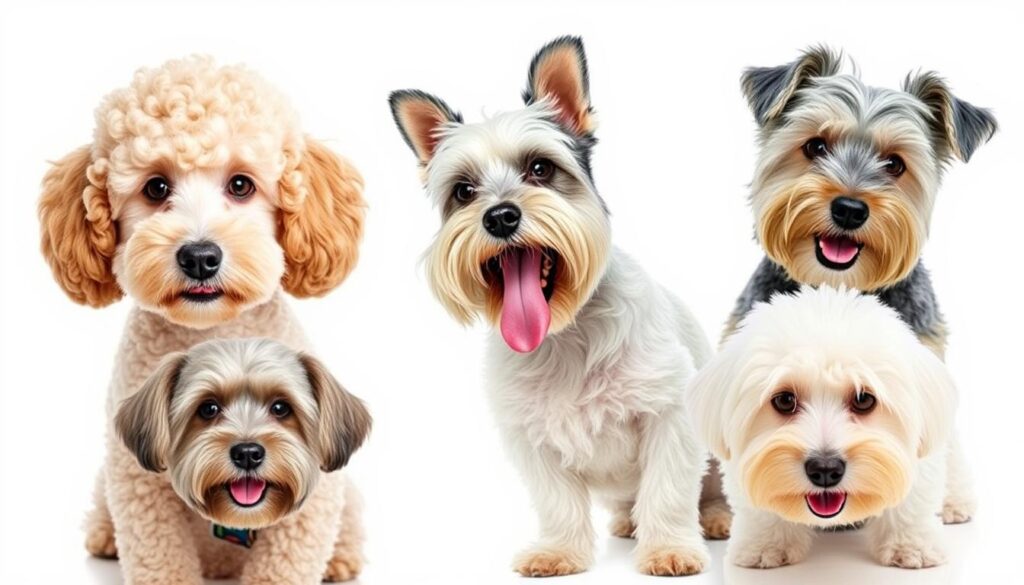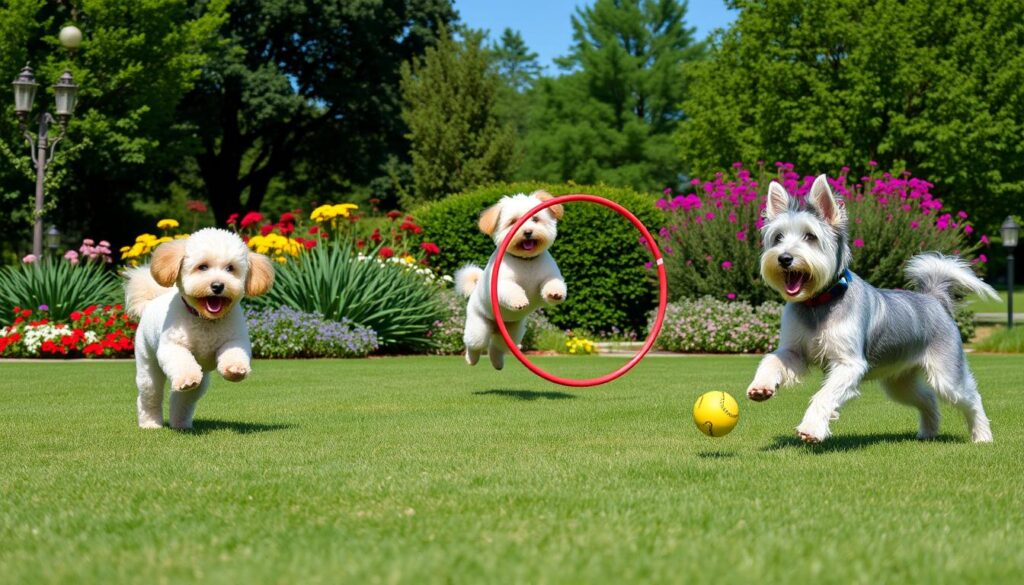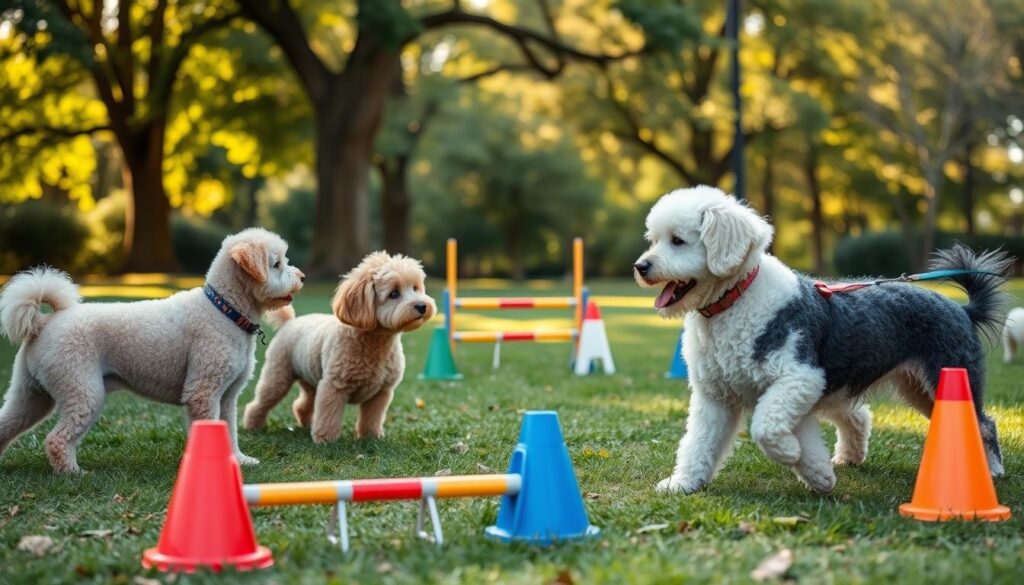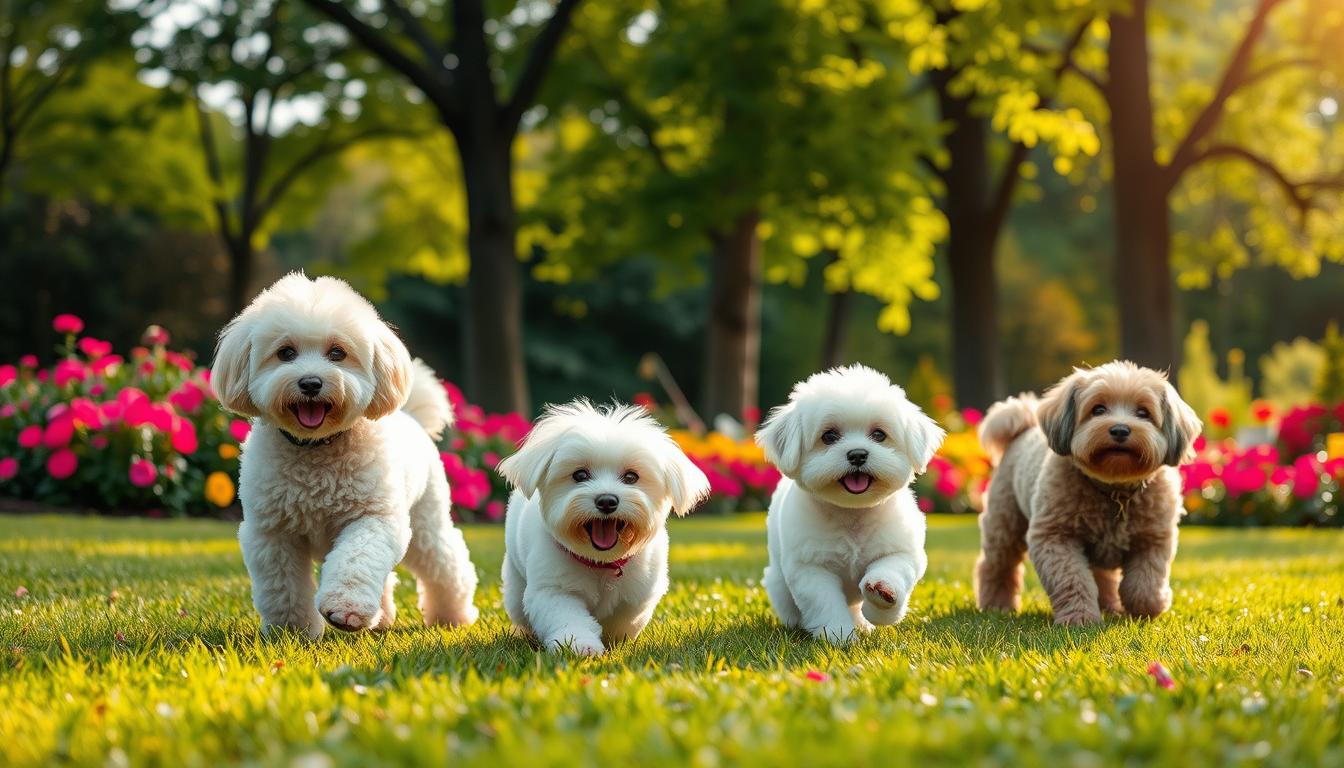Finding the right dog can be tough for those with allergies. Hypoallergenic dogs are a good choice because they produce less dander. This makes them a great option for people with dog allergies. The Hypoallergenic Dogs guide explains that these breeds have special traits that make them friendly to allergies.
Hypoallergenic dogs are not completely free from allergens. But they are a better choice for those with allergies. Dogs like Poodles and Bichon Frise have low-shedding coats. This means there’s less dander in the air. Knowing about Hypoallergenic Dogs helps you make a smart choice when picking a breed.
Key Takeaways
- Hypoallergenic dogs are a good option for individuals with allergies
- These breeds have a low-shedding coat that reduces dander
- Allergy-friendly Dogs are not completely allergen-free
- Understanding breed characteristics is essential for making an informed decision
- Hypoallergenic dogs can make great companions for those with allergies
Understanding What Makes a Dog Hypoallergenic
Dog allergies are common, and Low-shedding Breeds are a popular fix. But what makes a dog hypoallergenic? It’s about the science of dog allergies. Allergies come from proteins in dog dander, saliva, and urine. These proteins get into the air when dogs shed, making it hard to avoid.
While Non-allergenic Dogs don’t exist, some breeds are better for allergy sufferers. They have less dander, the main allergen. Knowing about dander helps us see why some dogs are better for people with allergies.
The Science Behind Dog Allergies
Dog allergies happen when the body reacts too strongly to dander proteins. This reaction leads to symptoms like sneezing and itching. Low-shedding Breeds are less likely to cause these problems because they shed less.
Common Misconceptions About Hypoallergenic Dogs
Many think hypoallergenic dogs are completely safe, but they’re not. They may have fewer allergens, but can still cause reactions. It’s key to spend time with a breed before getting one to check for allergies.
Role of Dander in Dog Allergies
Dander is the main allergen in dog allergies. It’s tiny scales from a dog’s skin that fall off and get airborne. When breathed in, they can cause allergic reactions. Non-allergenic Dogs have less dander, making them safer for those with allergies. Understanding dander helps us reduce exposure and avoid allergic reactions.
The Truth About Hypoallergenic Dogs
While Best Hypoallergenic Dogs are a good choice for allergy sufferers, they might still cause some reactions. Dog Breeds for Allergies are not completely free from allergens. However, they are designed to produce fewer allergens than other breeds.
When looking into Best Hypoallergenic Dogs, consider a few things:
- Their coat type and shedding pattern
- Grooming needs
- Genetic factors that make them hypoallergenic
Remember, everyone’s allergies are different. What works for one person might not work for another. If you’re thinking about getting a Dog Breeds for Allergies, spend time with them first. This can help you see if you react to them.
Knowing the truth about Best Hypoallergenic Dogs and Dog Breeds for Allergies helps you make a smart choice. It’s about deciding if a hypoallergenic breed is right for you and your family.
Characteristics of Low-Allergen Dog Breeds
When looking at Hypoallergenic Dog Characteristics, several key factors are important. Top Hypoallergenic Dog Breeds often have special coat types and shedding patterns. These traits help reduce the amount of dander in the air.
Coat Types and Shedding Patterns
Some breeds have a single-layer coat, while others have a double coat. The single-layer coat sheds less, which is good for allergy sufferers. Also, curly or wiry coats trap dander, keeping it from becoming airborne.
Grooming Requirements
Regular grooming is key to keeping a breed hypoallergenic. This includes daily brushing, regular baths, and trimming to avoid matting. Keeping the coat clean and well-maintained reduces dander in the environment.

Understanding low-allergen dog breeds is vital for choosing a pet. Consider coat type, shedding pattern, and grooming needs. This way, people with allergies can find a breed that fits their lifestyle.
Small Hypoallergenic Dog Breeds
For those with allergies, small hypoallergenic dog breeds are a great pick. They are ideal for anyone looking for a small, non-allergenic pet. Hypoallergenic dogs are perfect for bringing a furry friend home without fear of allergic reactions.
Some popular small hypoallergenic dog breeds include:
- Maltese: Known for their silky, white coats, Maltese are a popular choice for those with allergies.
- Yorkshire Terrier: With their small size and low-shedding coat, Yorkshire Terriers are a great option for allergy-friendly dogs.
- Bichon Frise: This playful breed has a hypoallergenic coat that requires regular grooming but produces less dander than other breeds.
These small hypoallergenic dog breeds are perfect for families or individuals who want a low-maintenance, allergy-friendly companion. With proper care and attention, hypoallergenic dogs can make wonderful pets for those with allergies.
Medium-Sized Allergy-Friendly Dogs
For those with allergies, medium-sized Low-shedding Breeds are a great pick. They are often seen as Non-allergenic Dogs because they don’t shed much. Popular breeds in this size include the Schnauzer, Soft Coated Wheaten Terrier, and Standard Poodle.
When looking at a medium-sized Low-shedding Breed, it’s key to know their needs. Here are some things to think about:
- Grooming needs: They need regular grooming to avoid fur mats and tangles.
- Exercise needs: They need regular exercise to stay happy and healthy.
- Training: Consistent training is key to good behavior and avoiding bad habits.
Medium-sized Non-allergenic Dogs can be great friends for those with allergies. With the right care, they can live happily and bring joy for many years.
Large Hypoallergenic Breeds
Looking for a big pet? There are many Best Hypoallergenic Dogs that are great companions. They are perfect for families with allergies because they don’t produce as many allergens as other dogs.
Some top Dog Breeds for Allergies are the Standard Poodle, Portuguese Water Dog, and Afghan Hound. Each breed has its own special traits, personalities, and needs. This makes them fit for different kinds of owners.
Standard Poodle
The Standard Poodle is very smart and active. They need lots of exercise and grooming. Their low-shedding coat is great for people with allergies.
Portuguese Water Dog
The Portuguese Water Dog is loyal and full of energy. They need regular exercise and mental play. Their low-shedding coat and smarts make them easy to train.
Afghan Hound
The Afghan Hound is gentle and likes to do their own thing. They need regular grooming and exercise. Their thick, fine coat sheds very little, which is good for allergy sufferers.
Choosing a large hypoallergenic breed means thinking about their exercise, grooming, and personality. This way, you can find the perfect pet that fits your lifestyle and allergy needs.
Grooming Requirements for Hypoallergenic Dogs
Regular grooming is key for Hypoallergenic Dog Characteristics to reduce shedding and dander. This makes them perfect for those with allergies. To keep your dog clean and healthy, it’s important to know their grooming needs. This includes daily brushing, weekly baths, and regular trims to avoid matting and tangling.
Here are some grooming tips for your hypoallergenic dog:
- Brush your dog daily to reduce shedding and prevent hair from getting everywhere
- Use a gentle shampoo and conditioner suitable for your dog’s coat type
- Trim your dog’s coat regularly to prevent matting and tangling
- Clean your dog’s ears and eyes regularly to prevent infections
By following these tips, you can reduce your dog’s shedding and dander. This makes them a great companion for people with allergies. Always consult with a vet or professional groomer for specific advice on grooming your Hypoallergenic Dog Characteristics.
Regular grooming does more than just reduce shedding and dander. It also strengthens the bond between you and your dog. With the right grooming routine, you can enjoy a happy and healthy relationship with your Top Hypoallergenic Dog Breeds.
Creating an Allergy-Friendly Home Environment
For those with pet allergies, making a home allergy-friendly is key when getting Hypoallergenic Dogs. While no dog is completely allergen-free, steps can be taken to lessen allergic reactions. Using air purification systems can help remove allergens from the air, making it easier for people with allergies to breathe.
Regular cleaning and keeping pets away from furniture are also crucial. The American Kennel Club says early exposure to pets may prevent allergies later. This is especially true for families with Allergy-friendly Dogs, making a safe and healthy home for both dogs and owners.
Air Purification Systems
Air purification systems can effectively reduce allergens at home. These systems remove particles and allergens from the air, helping those with allergies breathe better. Popular options include HEPA filters and ionizers.
Cleaning Tips and Routines
Regular cleaning is vital to reduce allergic reactions. This includes vacuuming and dusting often, and washing bedding and toys in hot water. It’s also key to keep pets away from furniture and out of certain home areas, like the bedroom.
Designated Pet-Free Zones
Creating pet-free zones can help reduce allergic reactions. This can include areas like the bedroom or living room, where pets are not allowed. By keeping pets out of these zones, individuals with allergies can lower their exposure to allergens. This makes a safer and healthier space for themselves and their Hypoallergenic Dogs.
Exercise Needs of Low-Shedding Breeds
Regular exercise is key for the health of Low-shedding Breeds. These dogs need daily activity to stay happy and healthy. Most Non-allergenic Dogs need at least 30 minutes of exercise each day.
Some good exercises for Low-shedding Breeds include:
- Daily walks
- Playtime in the yard or park
- Swimming or hydrotherapy
- Short runs or jogs
Remember, every dog is unique, and their exercise needs can differ. Talk to a vet to find the best exercise plan for your Non-allergenic Dog.

Regular exercise helps keep your Low-shedding Breed physically and mentally fit. It reduces the risk of obesity, anxiety, and other health issues. Exercise also strengthens your bond with your dog, making your relationship happy and healthy.
Diet Impact on Allergenic Properties
The diet of Best Hypoallergenic Dogs is key in managing their allergens. A balanced diet rich in nutrients can cut down on shedding and dander. This makes them a good fit for those with allergies. Dog Breeds for Allergies need a diet that keeps their skin and coat healthy, reducing allergens.
A healthy diet for these dogs should have high-quality proteins, whole grains, and essential fatty acids. These nutrients keep their coat healthy, reducing shedding and dander. Some Best Hypoallergenic Dogs might need special diets, like limited ingredient diets or novel proteins, to manage their allergens.
For Dog Breeds for Allergies, supplements can also help. They support skin and coat health, reducing shedding and improving coat condition. Supplements like omega-3 fatty acids, vitamin E, and antioxidants are common for hypoallergenic dogs.
Nutrition and Coat Health
- High-quality protein sources
- Whole grains
- Essential fatty acids
Supplements for Skin and Coat
By giving a balanced diet and supplements for skin and coat, owners of Best Hypoallergenic Dogs can lessen their allergens. This makes their homes more comfortable for people with allergies.
Cost Considerations for Hypoallergenic Breeds
Thinking about getting a hypoallergenic dog? It’s key to consider the costs. Hypoallergenic Dog Characteristics like low shedding and single-layer coats can affect the cost. Breeds like Poodles and Bichon Frise need regular grooming to avoid matting and tangling, which increases the cost.
The price to buy a hypoallergenic dog can be from $500 to $5,000 or more. This depends on the breed and its bloodlines. Grooming costs can be $30 to $90 per session, based on the dog’s size and coat. Also, regular vet visits, including vaccinations and check-ups, can cost $500 to $1,000 a year.
- Food and treats: $500 to $1,000 per year
- Toys and supplies: $100 to $300 per year
- Training and socialization: $50 to $100 per session
Understanding the costs of owning a hypoallergenic dog helps you make a smart choice. It ensures you’re ready to give your new pet the best life.
Training and Socialization Tips
Training and socialization are key for Hypoallergenic Dogs. They help your pet behave well and adjust to their new home. This ensures a happy and healthy bond between dog and owner.
For Allergy-friendly Dogs, learning basic commands is a must. Teach them to “sit,” “stay,” and “come.” Use positive methods like treats and praise to help them learn.
Basic Obedience Training
- Start with short training sessions to avoid overwhelming the dog
- Use positive reinforcement techniques, such as treats and praise
- Be consistent in your commands and expectations

Behavioral Characteristics
Knowing how Hypoallergenic Dogs behave is important. They need regular exercise, mental play, and social time. This keeps them happy and stress-free.
By following these tips, owners of Allergy-friendly Dogs can raise well-adjusted pets. These pets will be loving and well-behaved family members.
Health Considerations and Regular Care
As a responsible owner of Low-shedding Breeds, knowing about health issues is key. Regular vet visits are crucial to catch problems early. Common issues include skin allergies, ear infections, and eye problems.
To keep your dogs healthy, feed them well, exercise them regularly, and keep their space clean. Regular grooming helps prevent fur problems that can lead to skin issues. Also, keep them up-to-date on vaccinations and preventatives to protect them from diseases.
Here are some tips to keep your Low-shedding Breeds healthy:
- Provide a balanced and nutritious diet
- Ensure regular exercise and mental stimulation
- Keep their living environment clean and hygienic
- Regular grooming to prevent matting and tangling
- Stay up-to-date on vaccinations and preventatives
By following these tips and being aware of health issues, you can ensure your Non-allergenic Dogs live a long, happy life. Regular vet visits are key to catching health problems early. So, make sure to schedule regular vet appointments.
Adoption vs Breeding: Finding Your Perfect Match
Looking for Best Hypoallergenic Dogs? You might wonder if you should adopt or breed. Adopting gives a loving home to a dog in need. Breeding lets you pick a Dog Breeds for Allergies that fits your life.
Think about a few things before deciding. If adopting, look into local rescue groups for Hypoallergenic Dogs. If breeding, ask the right questions for a healthy puppy.
Questions to Ask Breeders
- What is the breed’s history and temperament?
- Can I meet the puppy’s parents?
- What health clearances have been performed on the parents?
Rescue Organizations Specializing in Hypoallergenic Dogs
Many rescue groups focus on Best Hypoallergenic Dogs. They help dogs find homes, often because of their breed or allergies. Adopting from them means finding a loving companion for your family.
Living Your Best Life with a Hypoallergenic Companion
Hypoallergenic dog breeds are a great choice for those who want a pet without allergies. They have special traits that make them perfect for your home. This way, you can enjoy a pet without sneezing or sniffling.
There are many top hypoallergenic dog breeds to pick from. You might like a Standard Poodle’s elegance, a Maltese’s fun nature, or a Portuguese Water Dog’s loyalty. With the right care and grooming, owning a dog can be wonderful without allergies.
Starting your journey with a hypoallergenic dog? Do your homework, find good breeders or rescues, and get ready to care for your new friend. With some planning and lots of love, you’ll have a great life with your new dog.
FAQ
What are hypoallergenic dogs?
Hypoallergenic dogs are breeds that don’t trigger allergies as much. They make fewer allergens like dander, saliva, and urine. This makes them great for people with dog allergies.
Why are some dogs considered hypoallergenic?
Some dogs have special coats that don’t shed much. This means they make fewer allergens. So, they’re called hypoallergenic because they’re less likely to cause allergies.
Do hypoallergenic dogs guarantee no allergic reactions?
No, even hypoallergenic dogs can still cause allergies in some people. They might make fewer allergens, but they can’t stop all allergic reactions. Remember, no dog is 100% hypoallergenic.
What are the characteristics of hypoallergenic dog breeds?
Hypoallergenic dogs have unique coats that don’t shed much. They might also produce less dander and saliva. Grooming these breeds is key to keeping their coats clean and reducing allergens.
What are some popular small hypoallergenic dog breeds?
Small hypoallergenic breeds include the Maltese, Yorkshire Terrier, and Bichon Frise. These dogs have low-shedding coats and are good for people with allergies.
Are there medium-sized hypoallergenic dog breeds?
Yes, there are medium-sized breeds like the Miniature Schnauzer, Poodle, and Portuguese Water Dog. They have low-shedding coats and produce fewer allergens.
What are some large hypoallergenic dog breeds?
Large hypoallergenic breeds include the Standard Poodle, Portuguese Water Dog, and Afghan Hound. They have low-shedding coats and make fewer allergens, making them good for people with allergies.
How important is regular grooming for hypoallergenic dogs?
Regular grooming is very important for hypoallergenic dogs. It helps reduce shedding and dander, which can cause allergies. Keeping up with grooming is key to keeping your dog healthy and allergen-free.
How can I create an allergy-friendly home environment for a hypoallergenic dog?
To make your home allergy-friendly, use air purifiers and have pet-free zones. Also, clean thoroughly. These steps help reduce allergens and make your home safer for you and your dog.
What are the exercise needs of low-shedding dog breeds?
Low-shedding breeds need regular exercise. They need walks, playtime, and structured activities. Knowing their exercise needs is important for their health and to prevent behavior problems.
How does diet impact the allergenic properties of hypoallergenic dogs?
A good diet can improve a hypoallergenic dog’s coat and reduce allergens. Proper nutrition and supplements can help lower shedding and dander, reducing allergen exposure.
What are the cost considerations for owning a hypoallergenic dog?
Hypoallergenic dogs can cost more due to grooming, special diets, and vet bills. It’s important to budget for these expenses to care for your hypoallergenic dog properly.
How important is training and socialization for hypoallergenic dogs?
Training and socialization are crucial for hypoallergenic dogs. Proper training helps them behave well and fit into your home and lifestyle.
What health considerations should I be aware of for hypoallergenic dogs?
Hypoallergenic dogs can have health issues like any other breed. It’s important to stay on top of vet visits and preventive care for their long-term health.
How can I find the right hypoallergenic dog for my family?
Look for hypoallergenic dogs through adoption or reputable breeders. Ask breeders questions and check out rescue groups for hypoallergenic breeds. Finding the right dog is key for a happy and allergy-friendly home.

